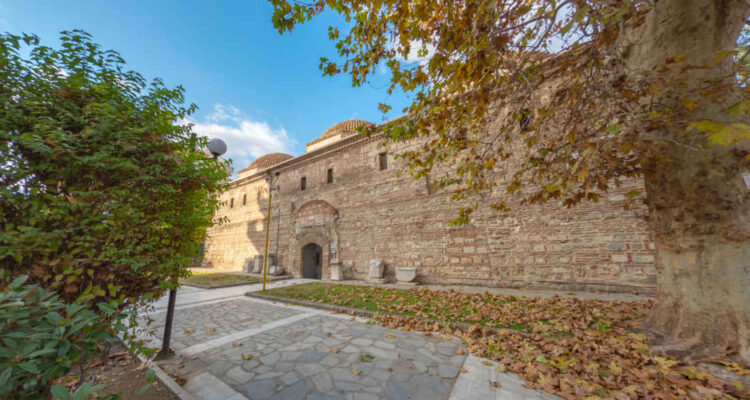The Archaeological Museum of Serres housed since 1970 in Bedesten (closed covered market) of the second half of the 15th century, located in the current city center. It was built based on the Byzantine markets model, and its name translates to cloth market. Today in Greece only two Bedesten are preserved, one of them is in Thessaloniki and the other one in Serres. The exhibits inside the museum are from the Middle and Late Neolithic era, Early and Late Bronze Age (pots, clay figurines), from the 4th to the 6th – 7th BC, the Roman times and the Hellenistic and Byzantine eras. For the first time, on October 1st, 1970, an archaeological museum was opened in the 3000 old city of Serres. This fact was and is of particular importance for the prefecture of Serres, because it finally began to exist archaeologically.
Bedesten is a wonderful Turkish rectangular building with external dimensions 31.45 X 20.60 meters. It presents an excellent architectural style externally and internally. It is covered by six spherical blind domes. It has four doors, one on each side, which are covered with iron. Their wall structure inside and outside, with the placing of stones and roof tiles, is masterful. The interior gives the impression of an archaeological museum to the visitor with its polygonal arches resting on the two large square pillars measuring 3.17 X 3.18 m.
Many architects and historians consider it the best of the Ottoman Bedesten. The Turkish traveler, Elvigia Tzelepis, in the 17th century, in his “travelogue” describes it “as a wonderful stone-built lead-roofed building”. It is characterized as one of kind Bedesten in Greece and the Balkans. It is one of the first buildings of the Turkish occupation in Serres. After the liberation of the city of Serres, many wanted to demolish it in order to expand Liberty Square (platia Eleftherias) or to develop it into flats, but it was saved due to its architectural value by the archaeologist Anastasios Orlandos. It was declared as a protected monument in 1938. It has been maintained multiple times. In 1938, the lower windows were closed and in 1955 the floor was tiled. In 1968, they installed tiles on the roof, because during the Bulgarian occupation the lead was removed. In 1969-70, the curator of antiquities of Kavala Mrs Haido Koukoulis, having the extraordinary curator of antiquities of Serres as an assistant, worked for more than a year for on the opening of the archaeological Museum. They gathered the scattered archaeological objects from all over the prefecture of Serres . After getting cleaned and welded by specialist craftsmen, the exhibits were placed for the first time in the museum exhibition. In 1973, the curator of Byzantine antiquities, Mrs. Elpida Kourkoutidou-Nikolaidou moved the Byzantine antiquities kept in the Holy Church of Saints Theodores to the Bedesten and created a section of Byzantine antiquities exhibits in the northwest corner. With the establishment of the Museum of Amphipolis, many archaeological exhibits from that area were transferred to the newly established Museum in Serres.
Most of the classical and Byzantine exhibits of the Museum are made of stone. Some are of clay and a few of copper and are placed in glass cases.
Copyright 2023 © Created By Diadyktio, All Rights Reserved.
To provide the best experiences, we and our partners use technologies like cookies to store and/or access device information. Consenting to these technologies will allow us and our partners to process personal data such as browsing behavior or unique IDs on this site and show (non-) personalized ads. Not consenting or withdrawing consent, may adversely affect certain features and functions.
Click below to consent to the above or make granular choices. Your choices will be applied to this site only. You can change your settings at any time, including withdrawing your consent, by using the toggles on the Cookie Policy, or by clicking on the manage consent button at the bottom of the screen.

Congratulation!